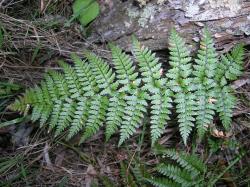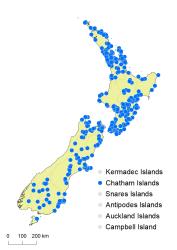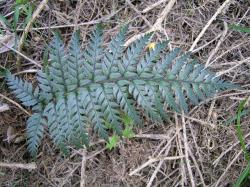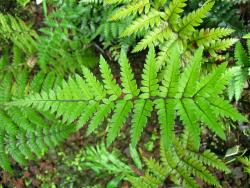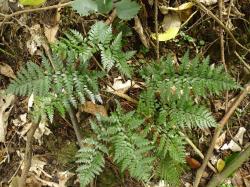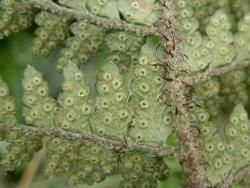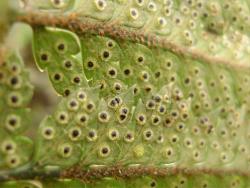- = Aspidium richardii Hook., Sp. Fil. 4, 23, t. 222 (1862) – as richardi
- ≡ Polystichum richardii (Hook.) J.Sm., Hist. Fil. 220 (1875)
- ≡ Dryopteris richardii (Hook.) Kuntze, Revis. Gen. Pl. 2, 813 (1891) – as richardi
- = Aspidium zerophyllum Colenso, Trans. & Proc. New Zealand Inst. 29: 418 (1897)
- ≡ Polystichum zerophyllum (Colenso) C.Chr., Index Filic. 98, 589 (1906)
- ≡ Polystichum aculeatum var. zerophyllum (Colenso) Domin, Biblioth. Bot. 20(85): 56 (1913)
- ≡ Polystichum neozelandicum subsp. zerophyllum (Colenso) Perrie in Perrie et al., New Zealand J. Bot. 41: 209 (2003)
Rhizomes erect, densely scaly. Rhizome scales narrowly ovate, 7–15 mm long, 1–2 mm wide, bicolorous with dark centres and narrow pale margins, margins toothed. Fronds 140–1000 mm long. Stipes 50–560 mm long, yellow-brown, abundantly scaly throughout; scales at very base similar to those of rhizome; those at mid-stipe narrowly ovate, blackish-brown, apices acuminate, margins with a few protrusions, bases densely fimbriate; those from the stipe/rachis junction 135–570 μm wide at mid-length. Rachises yellow-brown, sulcate, narrowly winged only at distal end, abundantly scaly. Laminae 2-pinnate or rarely 3-pinnate proximally, ovate or elliptic, 90–600 mm long, 32–235 mm wide, dark green adaxially, paler green abaxially, coriaceous, bearing abundant pale brown scales on abaxial costae and lamina surfaces, sparsely scaly on adaxial costae, ± glabrous on adaxial lamina surface. Primary pinnae in 9–26 pairs below pinnatifid apex, slightly overlapping distally, narrowly ovate to ovate; the longest at or near the middle, 18–140 mm long (very rarely to 185 mm long), 10–48 mm wide, apices acuminate, bases stalked; costae winged throughout. Secondary pinnae decreasing gradually in length along the primary pinna to the distal end; the longest secondary pinnae narrowly ovate or narrowly elliptic to ovate, 5–30 mm long, 3–13 mm wide, apices often acute to sharply acute or occasionally obtuse, margins entire or serrate, bases adnate or stalked. A few tertiary segments rarely present on proximal pinnae, ovate, up to 10 mm long and 4 mm wide. Sori round, medial or nearer margin than costa; indusia round, 0.9–1.5 mm diameter, with conspicuous dark central area (5–60% of surface area). Mean spore size 46–58 μm long, 36–45 μm wide.
Polystichum neozelandicum is distinguished by the scales at the stipe/rachis junction, which are narrowly ovate, blackish-brown, ciliate on the margins and sparsely fimbriate at their bases (Perrie et al. 2003a, fig. 5). The indusia have a conspicuous black centre (ibid., fig. 6). The laminae are dark green on the adaxial surfaces and paler green abaxially. It is likely to be confused only with P. oculatum, which has broader scales (135–570 μm wide, cf. 770–2280 μm wide) and smaller spores (36–48 μm long, 27–36 μm wide, cf. 46–58 μm long, 36–45 μm wide). Further, while the primary costae and lamina are concolorous on the abaxial surface in P. oculatum, the primary costae are usually darker in P. neozelandicum (concolorous exceptions being mostly confined to Otago).
Polystichum neozelandicum is distinguished from most of the naturalised species by its lack of bulbils, from P. vestitum and P. sylvaticum by its concolorous rather than bicolorous scales at the stipe/rachis junction, from P. cystostegia by its flat rather than inflated indusia, and from P. wawranum by its broader scales and indusia with prominent dark centres. P. neozelandicum can also be distinguished by having stalked secondary pinnae only in the proximal half of the primary pinnae, whereas P. vestitum and P. sylvaticum have stalked secondary pinnae extending into the distal half of the primary pinnae.
North Island: Northland, Auckland, Volcanic Plateau, Gisborne, Taranaki, Southern North Island.
South Island: Western Nelson, Sounds-Nelson, Marlborough, Canterbury, Westland, Otago, Southland, Fiordland.
Chatham Islands, Stewart Island.
Altitudinal range: 0–880 m.
Polystichum neozelandicum occurs in coastal, lowland and montane areas throughout the North Island from Te Paki to Wellington, although apparently absent from parts of inland Taranaki and the East Cape district. It ranges from sea level, up to 800 m in the Ruahine Ranges. It also occurs in coastal, lowland and montane areas throughout the South Island, but mainly east of the main divide, and is absent from most of Westland. It grows from near sea level to 880 m near the Riwaka River, north-west Nelson. It extends also to Stewart Island and the Chatham Islands.
Polystichum neozelandicum occurs in coastal, broadleaved, podocarp and beech forest, under mānuka and kānuka scrub, under conifer plantations and willows, and in regenerating bush, reverting pasture and among flax, usually in drier, well-lit conditions. It grows on coastal rocks and cliffs, hillsides, road cuttings, clay banks, river banks, alluvial terraces, tracksides, among rocks and tree roots, on rotting logs, and on the forest floor. It is found on greywacke, mudstone, scoria, limestone and sandy substrates.
There is evidence that Polystichum neozelandicum hybridises with P. oculatum and P. wawranum (Perrie et al. 2003a), and with P. vestitum (Perrie et al. 2003a, 2003b).
n = c. 164 (Perrie et al. 2003a).
Perrie et al. (2003a) recognised two subspecies within Polystichum neozelandicum – subsp. neozelandicum from Te Paki to Kāwhia and the Bay of Plenty, and subsp. zerophyllum from Taupō south to Stewart Island. AFLP DNA-fingerprinting analysis of populations of P. neozelandicum showed low genetic variation within each subspecies, but significant variation between them, suggesting quite different evolutionary lineages for the two groups. Perrie et al. (2003a) were unable to determine whether the two lineages represented two independent allopolyploid origins, or a single allopolyploid origin with subsequent divergence. However, despite the clear genetic distinction, Perrie et al. (2003a) found only slight morphological differences between the two groups. In particular, the dark central area of the indusia was larger in subsp. neozelandicum than in subsp. zerophyllum (15–60% cf. 5–30% of the surface area – see Perrie et al. 2003a, fig. 6). However, in practice the two groups were distinguished more readily by their geographical distribution (Perrie et al. 2003a, fig. 1). The two subspecies are not recognised here to be consistent with the treatment of other polyploids containing multiple lineages, such as Asplenium gracillimum (Brownsey & Perrie 2018).
The name Polystichum aristatum C.Presl, as used by Hooker (1854–1855), and combinations based on it, are misidentifications.
An abnormal form of P. neozelandicum with very short pinnae, collected on Kāpiti Island by A. Wilkinson, was identified as P. mohrioides (Bory) C.Presl (Allan 1961). Plants of P. cystostegia from the Auckland Islands and Campbell Island were also referred to this species by Kirk (1882). However, P. mohrioides was listed as erroneously reported for New Zealand by Brownsey et al. (1985).



